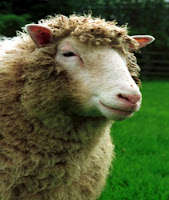The draft risk assessment presents an overview of assisted reproductive methods widely used in animal agriculture, the extensive scientific information available on animal health and food consumption risks, and draws science-based conclusions. These conclusions agree with those of the National Academies of Sciences, released in a 2002 report. Due to limited data on sheep clones, in the draft guidance FDA recommends that sheep clones not be used for human food.
"Based on FDA's analysis of hundreds of peer-reviewed publications and other studies on the health and food composition of clones and their offspring, the draft risk assessment has determined that meat and milk from clones and their offspring are as safe as food we eat every day," said Stephen F. Sundlof, D.V.M., Ph.D., director of FDA's Center for Veterinary Medicine. "Cloning poses no unique risks to animal health when compared to other assisted reproductive technologies currently in use in U.S. agriculture."
An animal clone is a genetic copy of a donor animal, similar to identical twins but born at different times. Cloning is not the same as genetic engineering, which involves altering, adding or deleting DNA; cloning does not change the gene sequence.
Proposed risk management plan: The proposed risk management plan addresses risks to animal health and potential remaining uncertainties associated with feed and food from animal clones and their offspring.
The proposed plan outlines measures that FDA might take to address the risks that cloning poses to animals involved in the cloning process. These risks all have been observed in other assisted reproductive technologies currently in use in common agricultural practices.
One such measure could be that the agency would work with scientific and professional societies with expertise in animal health and reproduction to develop a set of care standards for animals involved in the cloning process. Although the agency does not have authority to address the ethics of animal cloning, the proposed risk management plan does state that FDA plans to continue to provide scientific expertise to interested parties working on these issues.
"Because the release of the draft risk assessment and proposed risk management plan marks the beginning of our interaction with the public on these issues, we are continuing to ask producers of clones and livestock breeders to voluntarily refrain from introducing food products from these animals into commerce so that we will have the opportunity to consider the public's comments and to issue any final documents as warranted," said Sundlof.
Draft guidance for industry: The draft guidance for industry addresses the use of food and feed products derived from clones and their offspring. The guidance is directed at clone producers, livestock breeders, and farmers and ranchers purchasing clones. It provides the agency's current thinking on use of clones and their offspring in human food or animal feed.
In the draft guidance, FDA does not recommend any special measures relating to human food use of offspring of clones of any species. Because of their cost and rarity, clones will be used as are any other elite breeding stock -- to pass on naturally-occurring, desirable traits such as disease resistance and higher quality meat to production herds. Because clones will be used primarily for breeding, almost all of the food that comes from the cloning process is expected to be from sexually-reproduced offspring and descendents of clones, and not the clones themselves.
FDA is seeking comments from the public on the three documents for the next 90 days. To submit electronic comments on the three documents, visit accessdata.fda.gov/commentdocket. Written comments may be sent to: Division of Dockets Management (HFA-305), Food and Drug Administration, 5630 Fishers Lane, Rm. 1061, Rockville, MD, 20852. Comments must be received by Apr. 2, 2007 and should include the docket number 2003N-0573.
For more information, visit fda.gov/CloneRiskAssessment.
FOR IMMEDIATE RELEASE, P06-215, December 28, 2006, Media Inquiries: Michael Herndon, 301-827-6242, Consumer Inquiries: 888-INFO-FDA
dolly.jpg may be used free of charge by education, public sector or non-profit making groups. Commercial groups should request permission to use, and details of the associated nominal fee from roslin.design@bbsrc.ac.uk
Copyright: dolly.jpg © Roslin Institute, 2006. All rights reserved.
*image dolly.jpg fair use. This work is copyrighted and unlicensed. However, it is believed that the use of this work in the article FDA Safety of Animal Clones
- To illustrate the object in question
- Where no free equivalent is available or could be created that would adequately give the same information
- On the English-language Republican National Convention Blog, hosted on servers in the United States by beta.blogger.com
To the uploader: this tag is not a sufficient claim of fair use. You must also include the source of the work, all available copyright information, and a detailed fair use rationale. == Fair use for [[FDA Safety of Animal Clones]] == The image linked here is claimed to be used under fair use as:
- # it is a historically significant photo of a famous individual;
- # it is of much lower resolution than the original (copies made from it will be of very inferior quality)
- # the photo is only being used for informational purposes.
- # Its inclusion in the article adds significantly to the article because it shows the subject of this article and how the event depicted was very historically significant to the general public.












No comments:
Post a Comment